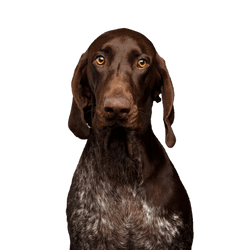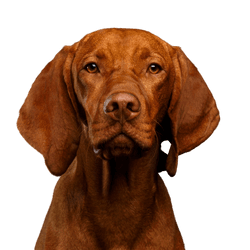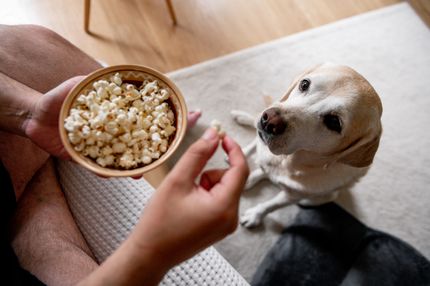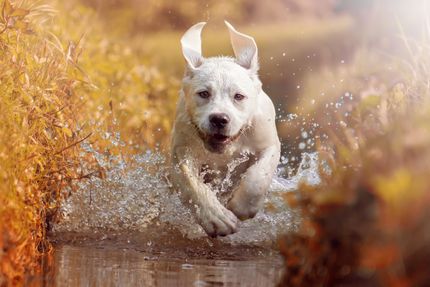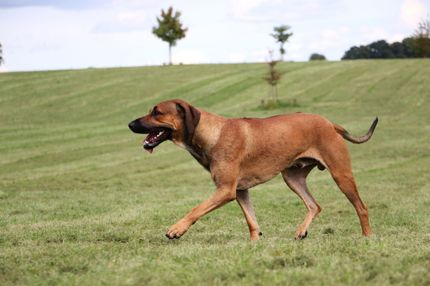Facts & Origin
German Shorthair and Magyar Vizsla Mix - a hybrid breed.
The Magyar Vizsla and German Shorthair mix is a cross between two renowned hunting dog breeds known for their intelligence, stamina and friendly temperament. This unique mixed breed, which combines both the physical characteristics and personality traits of both parent breeds, is often highly prized as a family dog and also as a working dog.
The Magyar Vizsla, also called the Hungarian Pointing Dog, originated in Hungary, where it has been used for hunting for centuries. It is known for its golden coat, gentle personality and remarkable versatility. The German Shorthair, on the other hand, also called German Shorthaired Pointing Dog, originated in Germany. It is known for its hardiness, its ability to work in different climates and terrains, and its appealing spotted coat.
The mixture of these two breeds can be found in different parts of the world, mainly in Europe and North America. However, their occurrence is rather rare, as purebred dogs are usually preferred. However, the mix of Magyar Vizsla and German Shorthair is becoming more and more popular, as it combines the best features of both breeds.
Because it is a mixed breed, appearance, temperament and health can vary greatly. It is therefore important that potential owners consider these aspects when choosing such a mixed breed.
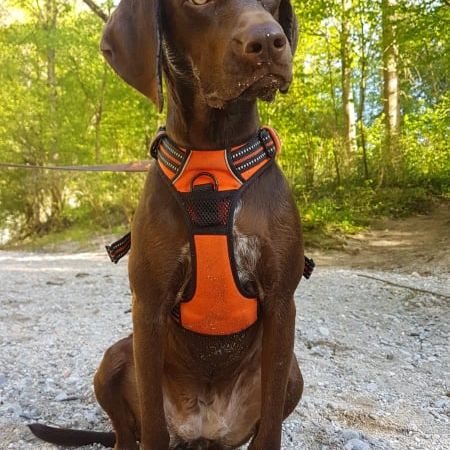
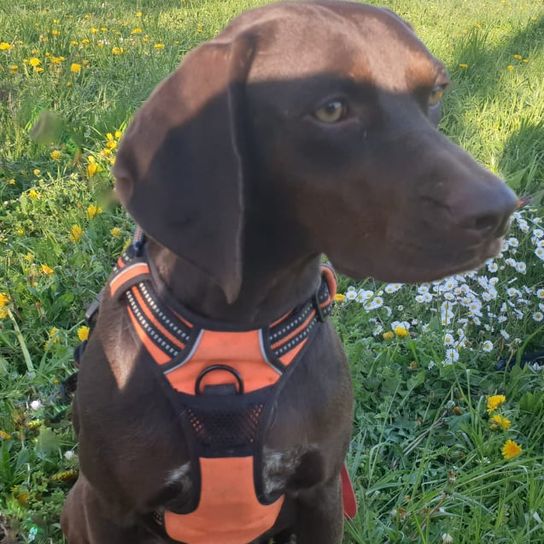
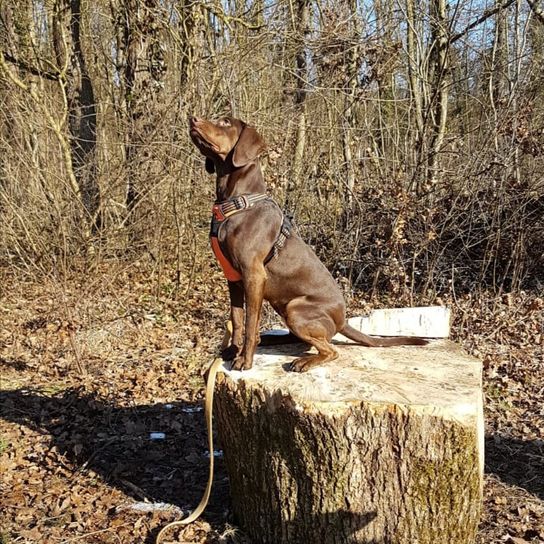
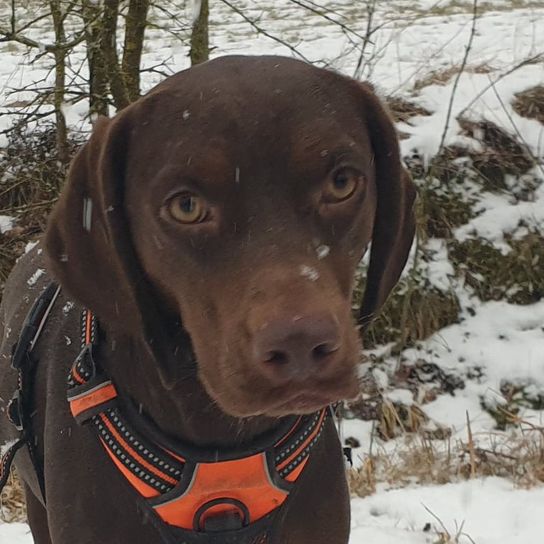
| Alternate Name | - |
| Origin | Germany - Hungary |
| Life expectancy | 12 - 15 years |
| Care requirements | low-maintenance |
| Activity level | average to high |
| FCI group | not recognised |
| AKC group | not recognised |
| KC group | not recognised |
More German Shorthaired Pointer mixes
More Magyar Vizsla mixes
Attitude, character and temperament of the breed
Possible character traits of German Vizsla Pointer - This is probably its nature
The character traits of a German Shorthair Pointer and Magyar Vizsla mix can vary greatly, as they depend on the inherited traits of the parents. However, both breeds are known for their intelligence, friendliness, and love of activity, so it is likely that a mixed breed will exhibit these traits.
Here are some possible traits that a mixed breed German Shorthaired Pointer and Magyar Vizsla might exhibit:
- Intelligence: both parent breeds are known for their intelligence. Therefore, it is likely that the mongrel will learn quickly and respond well to training.
- Activity: both the German Shorthaired Pointer and the Magyar Vizsla are active breeds that require a lot of exercise. A Mongrel will also likely require a high level of activity and will likely thrive in an active family or with an owner who enjoys spending a lot of time outdoors.
- Friendliness: Both parent breeds are known for their friendly and sociable temperaments. It is likely that the Mongrel will get along well with people and other animals.
- Loyalty: Both the German Shorthair Pointer and the Magyar Vizsla are known for their loyalty to their family. A mixed breed will likely be a loyal companion as well.
- Eagerness to Work: Both parent breeds are working dogs that enjoy performing tasks. Therefore, a mixed breed could do well in activities such as agility, search and rescue, or as a therapy dog.
- Adaptability: since both parent breeds can work in a variety of environments, a mixed breed could likely do well in a variety of living conditions.
It is important to note that these traits can vary from dog to dog, and that the dog's upbringing and socialization will have a large impact on its temperament.
Character
Usage
What diseases can occur in Prager Rattler and Magyar Vizsla mix.
Mixed breeds between German Shorthair Pointer and Magyar Vizsla could develop several health problems that are known to occur in their respective parent breeds:
- Progressive Retinal Atrophy (PRA) could develop. This eye disease causes gradual deterioration of the retina and can lead to blindness. It is known to occur in many breeds of dogs, including the Magyar Vizsla.
- Hip dysplasia, a malformation of the hip joint, could occur. This is a common condition in many medium to large dog breeds, including the Magyar Vizsla and German Shorthair Pointer.
- Epilepsy could be a risk. This neurological disorder that causes seizures is known to occur in both breeds.
- Entropion, an eye condition in which the eyelid rolls inward, could develop. This condition is known to occur in many dog breeds, including the German Shorthair Pointer.
- Heart disease such as dilated cardiomyopathy, a condition in which the heart is enlarged and cannot pump efficiently, could occur. This problem is known to occur in many larger breeds of dogs.
It is important to note that these health risks can be minimized through responsible breeding practices and that not all mixed breeds will develop these health problems. It is advisable to purchase a puppy from a reputable breeder who performs health tests on the parent animals, and to have the puppy undergo regular veterinary checkups to detect and treat any health problems early.

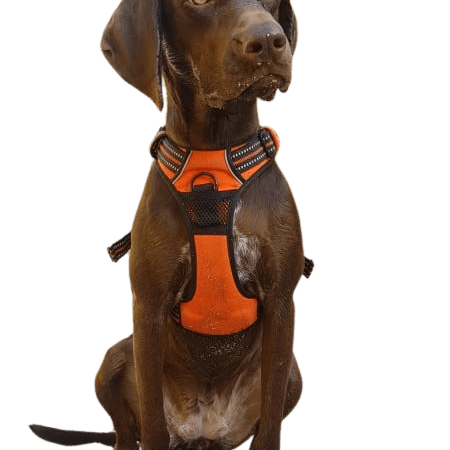
Breed characteristics and appearance of German Shorthair and Shorthair Magyar Vizsla mix.
The mixed breed of German Shorthair and Shorthair Magyar Vizsla combines the best features of both breeds. Both parent breeds are known for their learning ability, eagerness to work, and loyalty, traits that are also strongly expressed in the mixed breed.
Build and size
A German Vizsla Pointer is generally a medium to large sized dog. The size can vary, depending on the specific characteristics of the parents, but in general, this mixed breed dog can reach a height of 55 to 65 cm and a weight of 20 to 30 kg.
The build is typically robust and muscular, a trait inherited from both parent breeds. The back is straight and the chest is broad and deep, giving this dog a strong appearance.
Head and face
The head of this mixed breed is often medium sized with a pronounced forehead and stop. The eyes are usually medium sized, oval and dark with an intelligent and friendly expression. The ears are set high and hang down close to the head, similar to a purebred German Shorthair.
Coat and Color
The coat of the German Shorthair and Shorthair Magyar Vizsla Mix is typically short, dense, and smooth with a firm texture, allowing for easy grooming. Coat color can vary greatly, ranging from the typical brown tones of the Magyar Vizsla to the various shades of black, brown and white common in the German Shorthair.
Breed characteristics of the German Vizsla Pointer
A German Shorthair and Shorthair Magyar Vizsla mix usually inherits the strong hunting instinct and high learning ability of its parent breeds. These dogs are known for their energy and stamina, which makes them excellent companion dogs for active families. They are also known for their friendliness and even temperament, which makes them great family dogs.
In summary, a German Shorthair and Shorthair Magyar Vizsla mix is a fascinating mixed breed that combines both the physical and temperamental traits of their parent breeds. Their attractive appearance and friendly nature make them a great choice for anyone looking for an active and loyal companion dog.
| Fur length | short |
| Fur | flat coated |
| Ear shape | Floppy Ear |
| Tail | short - lang |
| Anatomy | sporty, sporty |
| Size ♀ | 53 - 61 cm |
| Weight ♀ | 18 - 27 kg |
| Size ♂ | 56 - 64 cm |
| Weight ♂ | 20 - 32 kg |
| Suitable For | - |
FAQ
-
Mixed breeds of German Shorthaired Pointer and Magyar Vizsla are usually family-oriented dogs that can get along well with children, provided they are properly socialized and the children are taught how to care for dogs respectfully and safely.
Both parent breeds are known for their friendliness, patience and playfulness, which makes them good candidates for family dogs. They are usually tolerant of the energy and noises that children often bring, and can form close bonds with the children in their family.
However, it is important that both the dog and the children learn to be respectful of each other. Children should be taught how to pet and handle a dog properly, and they should never be left unsupervised with a dog, no matter how trustworthy the dog may seem.
In addition, just like people, dogs can have individual personalities and tolerances. Therefore, it is important to carefully monitor the interactions between your dog and your children to ensure that both parties are comfortable and safe.
-
Mixed breeds of German Shorthaired Pointer and Magyar Vizsla likely inherit the hunting abilities of their parent breeds. Both breeds are known for their versatility and adaptability in the field and can perform a variety of tasks. Here are some of the skills these mixed breeds are likely to have:
Sense of smell: Both the German Shorthair and the Magyar Vizsla have a keen sense of smell and are excellent tracking dogs. They can be used to find and track game.
Retrieving: Both breeds are natural retrievers and can be trained to find fallen game and bring it back to their human.
Endurance: These mixed breeds are likely to inherit the endurance of their parent breeds and can work intensely for long periods of time.
Water Work: Both the German Shorthair and the Magyar Vizsla are good swimmers and can be used to hunt in watery areas.
Versatility: These mixed breeds can likely perform a variety of hunting tasks, from tracking to retrieving to working in different types of terrain.
Obedience and trainability: both breeds are known for their intelligence and desire to please, making them very trainable dogs.
It is important to note that although these mixed breeds will likely have these abilities, each dog is an individual and has its own strengths and weaknesses. Training and socialization play a large role in the development of a dog's abilities.
-
A mixed breed German Shorthaired Pointer and Magyar Vizsla can theoretically be kept in an apartment, provided that its physical and mental needs are sufficiently met. Both breeds are active and energetic and require plenty of daily exercise and mental stimulation. Without adequate exercise and activity, these dogs may show signs of restlessness or undesirable behavior.
-
Training a mixed breed of German Shorthaired Pointer and Magyar Vizsla should build on the strong points of both breeds. These dogs are usually intelligent, energetic and willing to work, which can make training easier. Here are some tips for training:
Positive reinforcement: both breeds respond well to positive reinforcement. Reward your dog with praise, treats or toys when he performs the desired behavior. This will help him form a positive association with the training.
Early socialization: start socializing your dog at a young age. Make sure he has lots of positive experiences with different people, places and situations. This will help him grow up to be a balanced and confident dog.
Consistency: be consistent in your instructions and expectations. For example, if you don't want your dog to lie on the sofa, always enforce this.
Mental and physical exercise: Both breeds are active and intelligent, and they need plenty of exercise and mental stimulation. Incorporate activities such as walks, games, agility training or nose work into your dog's daily routine.
Patience: all dogs learn at their own pace. Be patient with your dog and celebrate his progress, no matter how small.
Professional help: don't hesitate to enlist the help of a professional dog trainer if you need assistance. They can help you create an effective training program and manage any behavioral problems.
Remember that any training should be based on the trust and bond between you and your dog. A well-trained dog is a happy dog, and training can be a great way to strengthen your bond with your dog.
-
The weight of the mixed breed will also depend on the parent breeds. Since both the Magyar Vizsla and the German Shorthair Pointer typically weigh between 20 and 30 kilograms, it stands to reason that the mongrel will be of similar weight.

